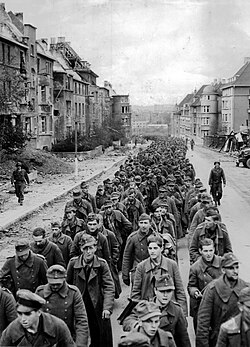ساواش اسیری

ساواش توتساغی یوخسا ساواش اسیری, سیلاحلی بیر ساواش سیراسیندا یوخسا سونراسیندا, رقیبطرف طرفیندن جانلی شکیلده اله گچیریلن و گؤزآلتیندا توتولان عسگر و یا عسگرلردیر. "ساواش اسیری" قاورامینین قولانیلدیغی ان قدیم قایناق ۱۶۱۰-ـه قدر اوزانماقدادیر.[۱]

گئچمیش ساواش لاردان الده ادیلن بیلگی و تجرولهلره گؤره، اسیر اله گچیریلدیگینده ایلک اولاراق خاریجدن تجرید اولوناراق گؤزآلتیندا توتولور. اسیرین گؤزو قاباغیندا، اؤز طرفلرینی گوجسوز و آشاغی گؤسترهجک تبلیغات آپاریلیر و اسیرلرین دویغولاری ایله فیکیرلری اؤز خئیرلرینه چئوریلمک ایستهنیلیر. اسیرلر هردن قول کیمی قارشیلانیر و آغیر ایشلرده چالیشدیرییر؛ بو سیرادا، ایش قضاسیندا آغیر یارالانان و اؤلن لر اولور بعضی عسگرلر ایسه اؤز آدلاریندان دؤیوشمک اوچون تشکیلاتلانیر و اؤیرهدیلیر. صلاحیتلی عسگرلردن و اسیرلردن سیاسی، دیپلوماتیک و یا حربی کشفیات معلوماتلاری آلینیر، لازیم گلدیکده ایشگنجهدن ایستیفاده ائدیلیر.[۲][۳]
قایناقلار
[دَییشدیر]- ^ جان هیکمن (۲۰۰۲). "ساواش نه اوچون دی؟". Scientia Militaria. 36 (2). Retrieved ۱۴ سپتامبر ۲۰۱۵.
- ^ "The Roman Gladiator" 26 Ocak 2020 tarihinde Wayback Machinesitesinde arşivlendi., The University of Chicago – "Originally, captured soldiers had been made to fight with their own weapons and in their particular style of combat. It was from these conscripted prisoners of war that the gladiators acquired their exotic appearance, a distinction being made between the weapons imagined to be used by defeated enemies and those of their Roman conquerors. The Samnites (a tribe from Campania which the Romans had fought in the fourth and third centuries BC) were the prototype for Rome's professional gladiators, and it was their equipment that first was used and later adopted for the arena. [...] Two other gladiatorial categories also took their name from defeated tribes, the Galli (Gauls) and Thraeces (Thracians)."
- ^ ohn Hickman (2002). "What is a Prisoner of War For". Scientia Militaria(İngilizce). 36 (2).